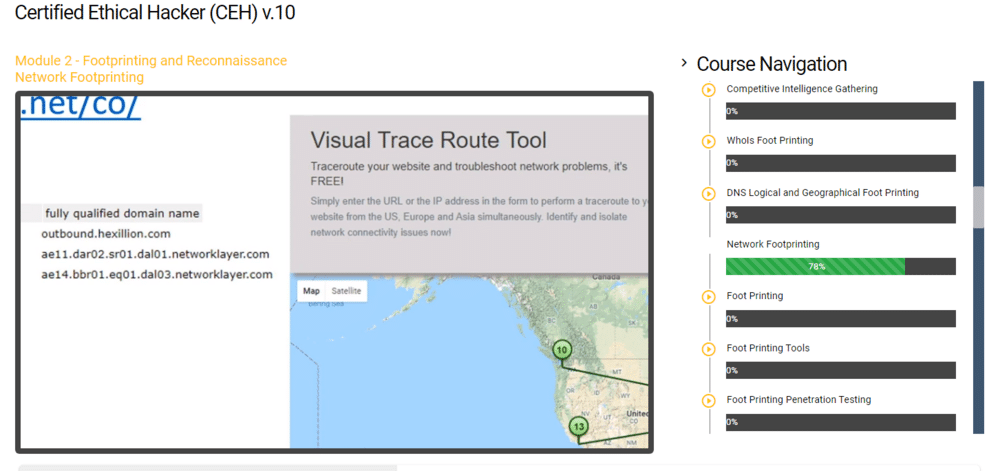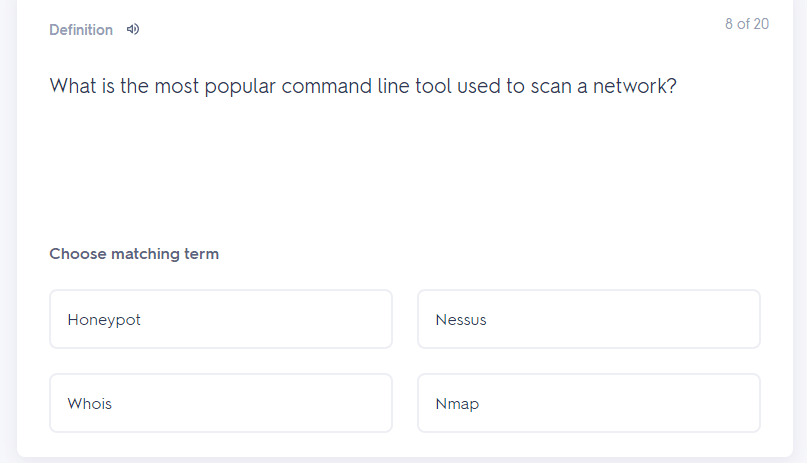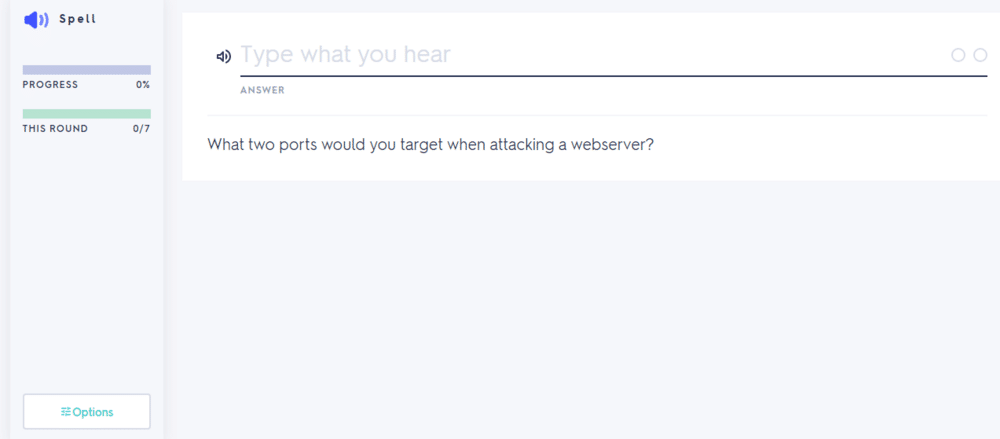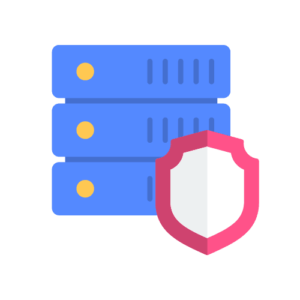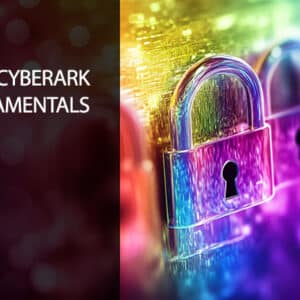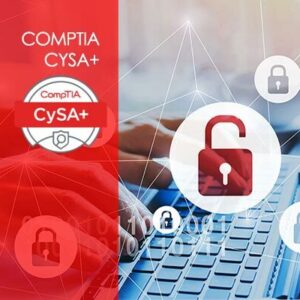Want to learn how to hack?
Unleash your inner cybersecurity superhero with the exhilarating “Ethical Hacking v10” course! This cutting-edge program is your passport to becoming a skilled white-hat hacker, proficient in the art of safeguarding networks and conducting system penetration testing. Are you ready to embark on an electrifying journey where you’ll master the techniques used by the world’s top cybersecurity experts?
Prepare to dive deep into the realms of ethical hacking as you explore the comprehensive syllabus meticulously designed to cover all exam objectives of the EC-Council ECC 312-50 version 10 exam. Equipped with this certification, you’ll stand out from the crowd, showcasing your unrivaled expertise in ethical hacking concepts and techniques.
Immerse yourself in an interactive and hands-on learning experience, where step-by-step guidance will transform you into a skilled hacker. Gain practical prowess through a fully virtual environment, specially crafted to provide you with a safe and immersive playground for honing your skills. From Windows to Kali Linux, you’ll wield an array of powerful tools to conquer each network and system type, equipping you with the diverse knowledge needed to tackle real-world cybersecurity challenges.
But the benefits of this course extend far beyond just passing an exam. By enrolling in the “Ethical Hacking v10” course, you’re embarking on a transformative journey that opens doors to limitless possibilities. Develop a solid foundation in cybersecurity studies, paving the way for advanced career opportunities and personal growth.
Join a vibrant community of cybersecurity enthusiasts and tap into the collective knowledge of like-minded professionals. Gain invaluable insights from industry experts who will guide you through a broad range of examples used by hackers, empowering you with a well-rounded skill set to combat evolving threats.
It’s time to unleash your potential and become the defender of the digital realm. Embrace the challenge, earn your Ethical Hacker certification, and showcase your proficiency to the world. Remember, EC-Council has not only recognized this course but has also praised its holistic approach to ethical hacking education. So why wait? Enroll now and embark on an exhilarating journey that will shape your future in cybersecurity.
How Much Can I Earn?
Due to the current emphasis on information security, ethical hackers can expect to earn an average income of between $107,000 and $115,000 per year in security-related employment in the United States. Penetration testers, security engineers, and IT security specialists frequently earn this certification. For the most recent data on the Ethical Hacker Salary in the United States, check out Indeed.com.
Course Outline:
Module 1 – Introduction to Ethical Hacking
Introduction
Introduction to Hacking
Information Security Threats and Attack Vectors
Hacking Concepts
Ethical Hacking Concepts and Scope
Information Security Controls Part 1
Information Security Controls Part 2
Information Security Laws and Standards
Module 2 – Footprinting and Reconnaissance
Footprinting and Reconnaissance
Footprinting Methodology
Google Hacking
FootPrinting Through Social Networking
Website Foot Printing
Email Foot Printing
Competitive Intelligence Gathering
WhoIs Foot Printing
DNS Logical and Geographical Foot Printing
Network Footprinting
Foot Printing
Foot Printing Tools
Foot Printing Penetration Testing
Conduct Recon with Ping Act
Query DNS with NSLookUp Act
Discover Website Subdomain with Sublist3r Act
Obtain OSINT Information About a Person with Pipl Act
Gather Contact and Host Information with the Harvester Act
Automate OSINT Research with Recon-ng Act
Get Started with Metasploit Act
Conduct Open Source Intelligence with OSR Framework Act
Obtain Whois Information with Smart Whois Act
Extract Links, URLs, and Emails from Websites with Web Data Extractor Act
Create an Offline Copy of a Website with the HTTrack Act
Trace an Email with eMail Tracker ProAct
Module 3 – Network Scanning
Network Scanning
Discovery Scans
Port Scans
Nmap
Nmap Stealth Scans
Nmap Options
H-ping and Other Scanners
SSDP Scanning
Scanning Beyond IDS and Firewall
Banner Grabbing
Scanning Pen Testing
Checking for Live Systems with Angry IP Scanner Act
Network Scanning with MegaPing Act
Advanced Scanning with Nmap Act
Packet Crafting with Hping3 Act
Packet Crafting with Colasoft Packet Builder Act
Module 4 – Enumeration
Enumeration
Enumeration Techniques Tools
NetBIOS Enumeration
SNMP Enumeration
LDAP Enumeration
NTP Enumeration
SMTP and DNS Enumeration
Enumeration Countermeasures
Enumeration Penetration Testing
Enumerate NetBIOS Information with SuperScan Act
Enumerate NetBIOS Information with NetBIOS Enumerator Act
Enumerate NetBIOS and LDAP Information with Hyena Act
Enumerate SNMP WMI and Other Information Using SoftPerfect Network Scanner Act
Module 5 – Vulnerability Analysis
Vulnerability Analysis
Vulnerability Assessment Solutions
Vulnerability Scoring Systems
Vulnerability Assessment Tools and Reports
Perform a Vulnerability Scan and Analysis with Nessus Act
Module 6 – Malware Threats
Malware Threats
Trojan Concepts
Trojan Types
Trojan Tools
Virus and Worm Concepts
Virus Types
Malware Analysis
Malware Reverse Engineering
Malware Detection
Malware Countermeasures
Malware Penetration Testing
Infect a Victim with a Remote Access Trojan Act
Module 7 – Sniffing
Sniffing Concepts
DHCP Attacks
MAC Attacks
ARP Poisoning
DNS Poisoning
Sniffing Tools
Sniffing Countermeasures
Sniff a Clear Text HTTP Session with Wireshark Act
Intercept and Crack a Network Login Act
Module 8 – Social Engineering
Social Engineering
Human-Based Social Engineering
Computer-Based Social Engineering
Additional Types of Social Engineering
Social Engineering Countermeasures
Social Engineering Penetration Testing
Fool a User with a Baited USB Stick Act
Harvest Credentials with Spear Phishing Act
Module 9 – Denial of Service
Denial of Service
Common Dos-DDoS Attack Types
Additional DoS Attack Types
BotNets
DoS Countermeasures
Additional DoS Countermeasures
DoS Penetration Testing
Perform a DoS Attack With the Low Orbit ION Cannon Act
Step Up the DoS Attack With the High Orbit ION Cannon Act
Perform a Slowloris DoS Attack Act
Module 10 – Session Hijacking
Session Hijacking
Browser Session Hijacking
Way to Compromise a Session Token
Client Side Attacks
Hijacking at the Network Level
Session Hijacking Tools
Session Hijacking Countermeasures
Session Hijacking Testing
Perform a MITM Attack with Ettercap Act
Module 11 – Hacking Webservers
Hacking Web Servers
Webserver Attacks
Methodology of Webserver Attacks
Webserver Attack and Defense Tools
Webserver General Defense
Webserver-Specific Attack Countermeasures
Webserver Patch Management
Webserver Pen Testing
Footprint a Web Server with IDServe Act
Conduct a Simple Web Server Vulnerability Scan with Uniscan Act
Conduct a Comprehensive Web Server Vulnerability Scan with Uniscan Act
Brute Force a Web Server with Medusa Act
Module 12 – Hacking Web Applications
Hacking Web Applications
Web App Vulnerabilities and Exploits
Web Application Threats
Injection Attacks
Hidden Fields and Clickjacking
Cross-Site Attacks
Additional Web App Attacks
Web Hacking Methodology
Web App Hacking Countermeasures
Web App Security Tools
Web Application Penetration Testing
Conduct a Simple Command Injection Attack Act
Inject a Malicious Link with Cross Site Scripting Act
Conduct a Cross-Site Request Forgery Attack
Module 13 – SQL Injection
SQL Injection
Types of SQL Injection
SQL Injection Methodology
SQL Injection Tools
SQL Injection Countermeasures
SQL Injection Penetration Testing
SQL Injection Act
Module 14 – Hacking Wireless Networks
Hacking Wireless Networks
Wireless Discovery and Mapping
WiFi Sniffers
WiFi Attacks
WiFi Cracking
Wireless Hacking Tools
Bluetooth Hacking
Wireless Hacking Countermeasures
Wireless Security Tools
Wireless Penetration Testing
Crack a WEP Key with Aircrack-ng Act
Crack a WPA Key with Aircrack-ng Act
Module 15 – System Hacking
System Hacking Methodology
Windows System Vulnerabilities and Exploits
Linux System Vulnerabilities and Exploits
Password Cracking Methods
Network Service Password Cracking
Windows Password Cracking
Linux Password Cracking
Password Cracking Tools
Other Methods of Obtaining Passwords
Keylogging
Spyware
RootKits
Hiding Files
Steganography
Privilege Escalation
Creating and Maintaining Remote Access
Hiding Evidence
System Hacking Penetration Testing
Spoof Name Resolution and Capture Credentials with Responder Act
Dump and Crack Password Hashes with pwdump7 and Ophcrack Act
Crack Passwords with L0pht7 Act
Exploit Client Side Vulnerabilities Act
Track User Activity with Spyware Act
View and Clear Audit Policies with Auditpol Act
Hide Data Using Whitespace Steganography Act
Hide Data Using Least Significant Bit Steganography Act
Cover Your Tracks Act
Module 16 – Hacking Mobile Platforms
Hacking Mobile Platforms
Hacking Android OS
Rooting Android
Securing Android
Hacking iOS
Jailbreaking iOS
Securing iOS
Hacking Windows Phone OS
Hacking Blackberry
Mobile Device Management
Mobile Security Guidelines and Tools
Mobile Penetration Testing
Prepare Your Wireless Email Environment Act
Pwn a Mobile Device with Metasploit Act
Use a Mobile Device in a DDoS Campaign Act
Return Your VMs to the Original Configuration Act
Uninstall Main Activity Malware from Android Act
Module 17 – Evading IDS, Firewalls, and Honeypots
Evading IDS Firewalls and Honeypots
Firewalls
Honeypots
IDS Firewalls and Honeypots Tools
Evasion
Evasion Countermeasures
IDS Firewall Honeypot Penetration Testing
Fly Below IDS Radar Act
Test and Analyze a Honey Pot Act
Bypass Windows Firewall Act
Module 18 – Cryptography
Cryptography
Encryption Algorithms
Cryptography Tools
Public key Infrastructure
Email Encryption
Disk Encryption
Cryptography Attacks
Cryptography Penetration Testing
Examine Hashing Algorithms Act
Protect Data with Symmetric Encryption Act
Protect Data with Asymmetric Encryption Act
Module 19 – Cloud Computing
Cloud Computing
Virtualization
Cloud Computing Threats
Countermeasures to Cloud Computing Threats
Cloud Computing Attacks
Cloud Security
Cloud Security Best Practices
Cloud Penetration Testing
Module 20 – IoT Hacking
IoT Hacking
IoT Vulnerabilities and Attacks
IoT Hacking Methodology and Tools
IoT Hacking Countermeasures
oT Penetration Testing
Search the Internet for Vulnerable IoT Devices Act
Conclusion

